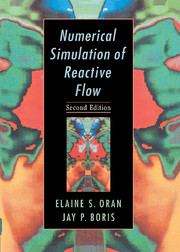Book contents
- Frontmatter
- Contents
- Prologue
- 1 An Overview of Numerical Simulation
- 2 The Reactive-Flow Modeling Problem
- 3 Models and Simulation
- 4 Some General Numerical Considerations
- 5 Ordinary Differential Equations: Reaction Mechanisms and Other Local Phenomena
- 6 Representations, Resolution, and Grids
- 7 Diffusive Transport Processes
- 8 Computational Fluid Dynamics: Continuity Equations
- 9 Computational Fluid Dynamics: Using More Flow Physics
- 10 Boundaries, Interfaces, and Implicit Algorithms
- 11 Coupling Models of Reactive-Flow Processes
- 12 Turbulent Reactive Flows
- 13 Radiation Transport and Reactive Flows
- Index
4 - Some General Numerical Considerations
Published online by Cambridge University Press: 09 October 2009
- Frontmatter
- Contents
- Prologue
- 1 An Overview of Numerical Simulation
- 2 The Reactive-Flow Modeling Problem
- 3 Models and Simulation
- 4 Some General Numerical Considerations
- 5 Ordinary Differential Equations: Reaction Mechanisms and Other Local Phenomena
- 6 Representations, Resolution, and Grids
- 7 Diffusive Transport Processes
- 8 Computational Fluid Dynamics: Continuity Equations
- 9 Computational Fluid Dynamics: Using More Flow Physics
- 10 Boundaries, Interfaces, and Implicit Algorithms
- 11 Coupling Models of Reactive-Flow Processes
- 12 Turbulent Reactive Flows
- 13 Radiation Transport and Reactive Flows
- Index
Summary
This chapter presents and analyzes the properties of the simplest finite-difference methods for simulating four of the main physical processes in reactive flows: chemical reactions, diffusion, convection, and wave motion. The material presented is an overview and short course on solving idealized forms of the equations representing these processes. The discussion highlights the features and weaknesses of these solution methods and brings out numerical difficulties that reappear in solutions of the complete set of reactive-flow conservation equations. Throughout the presentation, we list and describe the major computational and algorithmic trade-offs that arise in simulating each process separately.
The material presented here introduces the more advanced solution techniques described in Chapters 5 through 9. Chapter 11 deals with techniques for solving the coupled set of equations that forms the reactive Navier-Stokes equations discussed in Chapter 2. In particular, Chapter 11 shows how the disparate time and space scales of each type of process can be used to determine a reasonable overall timestep for the computation. The choice of the numerical boundary conditions that are so crucial for correctly defining the physical problem, are discussed in Chapters 5 through 9. Sections 10–1 and 10–2 are devoted to issues of selecting boundary conditions for the reactive-flow equations.
Table 4.1 shows the mathematical representations discussed in this chapter and indicates where the numerical solutions for more complex forms of these equations are discussed elsewhere in this book. There are many references on numerical methods and scientific computation for science and engineering that cover material complementary to this chapter.
- Type
- Chapter
- Information
- Numerical Simulation of Reactive Flow , pp. 70 - 113Publisher: Cambridge University PressPrint publication year: 2000

